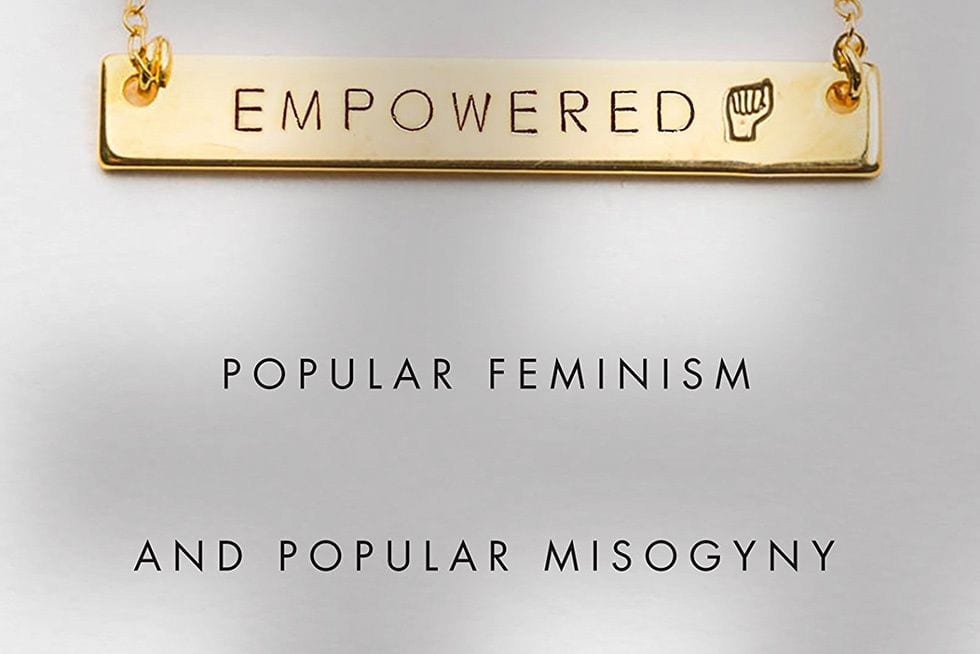
In Empowered: Popular Feminism and Popular Misogyny, Sarah Banet-Weiser examines the interconnections between popular feminism and popular misogyny. She contends visible forms of feminism are informed by discourses highlighting women’s and girls’ empowerment and agency. Frequently, popular feminism is met with misogynistic backlash. Doxxing, harassment, and violence reestablish systematic gender inequalities. More so, popular misogyny recuperates the economic, social, and cultural capital assumed to be seized by popular feminism.
Banet-Weiser relies on advertising, online and multimedia platforms, commercial campaigns, and political elections as the context for the emergence of popular feminism and misogyny. Yet, she doesn’t myopically exalt popular feminism. By addressing corporations’ use of feminist ideologies to focus on the individual and sell their products, she situates her text as a critique of popular feminism’s connection to neoliberalism. Empowered adroitly examines the context in which popular feminism is transformed into hateful and misogynistic rage.
Banet-Weiser understands popular feminism as the manifestation of discourses circulated in popular and commercial media, then mainstreamed by celebrity and corporate feminists, and global entrepreneurial projects focusing on the empowerment of women. She argues that “popular feminism is networked across all media platforms” (1) and is “active in shaping culture” (3). Banet-Weiser’s strongest analysis is of the relationship between feminism and capitalism, an accord that often eclipses feminist critiques while obscuring racism, violence, class, and other important cultural conditions. Yet the commodification of feminism can evoke dialogue and create visibility. For example, Banet-Weise situates CoverGirl’s #CanDo ad as a counternarrative, relying on celebrities to refute cultural stereotypes. However, the ad’s “celebration of beauty… as a rallying call for female empowerment” (52) privileges women’s physical beauty and sells cosmetics while leaving inequalities uncontested.
Indeed, throughout Empowered, she’s critical of when “seeing or purchasing feminism is the same thing as changing patriarchal structures” (4). Whereas the crux of her analysis focuses on the circulation of media expressions, she astutely expands her lens to problematize the consumerism, branding, and marketing of feminism.
Empowered expertly unpacks the neoliberal logic redressing individualism. In addition to CoverGirl, she uses high profile ad campaigns from Dove and Always to expose the “absence of collectivity in these ads, and there’s no gesture toward empowerment through solidarity, no critique of structural barriers” (53). Indeed, it’s nearly impossible to conceptualize an ad campaign where collectivity is emphasized. Even the GoldieBlox ads, lauded for featuring diversity, only feature the girls individually engaging with their inventions. The ad’s narrative implies the girls constructed the devices together, but collectivity is not captured on camera. Thus, solidarity is placed under erasure while the commodification of feminism is centralized. Here, Banet-Weiser’s theory is accurate: the neoliberal emphasis on individuality is problematic and hinders collective power. She concludes by calling for transforming popularity into “an intersectional collective rage” (184).
Banet-Weiser’s capacity and injury theory is central to the text. She sees popular feminism and popular misogyny stemming from twin discourses encouraging women’s and girl’s capitalistic and entrepreneurial capacity. It is this capacity that threatens to redefined male spaces or dominant concepts of masculinity, thereby causing injury. She includes consideration of men’s rights organizations, the insipid manscrimination campaigns, pick-up artists, and #GamerGate. Charting Anita Sarkeesian‘s ordeal with the online community is an illuminating example of women “representing an invasion into a territory [men] become quite comfortable in” (162). Readers will soon see the television show, The Big Bang Theory, the caustic response on social media to the Star Wars character Rey, and the rise of notorious incels as additional examples Banet-Weiser misses. As her argument unfolds, it’s apparent that popular misogyny is a reflection of the toxic communities maligning and attacking women to recuperate an idealized identity and space.
Recently, Fox News host Tucker Carlson blamed feminism for “men in decline”. He claimed women “generally don’t want to marry” men who earn less than them, thereby leading more men to addiction issues. Likely to his disapproval, Carlson’s statement is emblematic of Banet-Weiser’s capacity and injury theory. For Carlson, “the ‘matriarchy’ thats apparently taking over the workplace is seen by many as a threat to [men’s] very selves” (111). Beyond the Fox News charlatans, emasculation, job loss, economic hardship, and personal discontent are the basis for Trump’s “Make America Great Again”. According to Banet-Weiser, Trump’s illogical shibboleth is “primarily the recuperation of men whose very masculinity has been threatened” (111). Trump’s callow attempts at reinforcing masculinity is defined by his representation of women as “nasty”, “pigs”, and “whores” — language that ultimately undermines women’s capacity.
Much of Trump’s appeal stems from hardcore anti-intellectualism, a concept Banet-Weiser fails to address. Richard Hofstadter’s definition of anti-intellectualism as the “resentment of the life of the mind, and those who are considered to represent it; and a disposition to constantly minimize the value of that life” is especially helpful in understanding popular feminism and popular misogyny. Banet-Weiser goes as far as to document the online videos satirizing why girls can’t code but she doesn’t consider anti-intellectualism’s significance in framing these narratives.
Whereas Hofstadter’s text, Anti-Intellectualism in the United States (Knopf, 1963) is largely silent on race and gender, Empowered could develop the gaps. Intelligent women are often considered subversive and their invisibility is necessary to maintaining dominant masculinity. Empowered brings attention to women’s epistemological contributions without discussing the rejection of intellect or, in contrast, the disavowal of anti-intellectualism. Yet, anti-intellectual discourses are central to popular feminisms’ and misogynies’ reach and influence. Empowered must not only question experiences but also consider how social factors, power positions, and political economies alter knowledge and a person’s ability to express intelligence.
Empowered centralizes popular feminism’s ability to expose an injurious site where dominant masculinity is fallible. Throughout the text, Banet-Weiser carefully traces popular feminism as a defense against gendered inequalities while popular misogyny is the barricade against feminisms’ gains.

